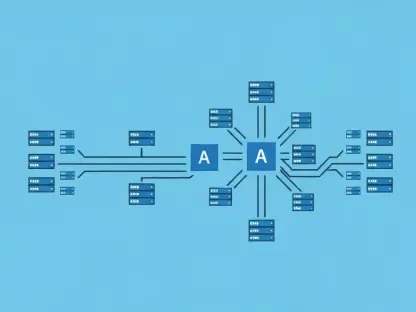The Kubernetes Technical Oversight Committee (TOC) has recently released a significant update to the Kubernetes platform, codenamed Penelope. This update has been designed with the goal of improving the system’s scalability and functionality, marking an important milestone in Kubernetes development. By introducing dynamic resource allocation (DRA) as a native feature, the process of scaling workloads dynamically has become more streamlined. This eliminates the necessity to restart clusters and reduces reliance on third-party plugins, facilitating seamless integration with specialized hardware components such as GPUs, FPGAs, and network adapters.
Key Enhancements in Kubernetes 1.32
Enhanced Scalability Through DRA
Frederico Muñoz, who led the release of Kubernetes 1.32, emphasized that the new update aims to supersede the DRA approach previously introduced in Kubernetes 1.26. The update offers both vertical and horizontal scaling solutions, addressing a notable pain point in the scalability of Kubernetes clusters. With the addition of 44 enhancements—comprising 13 stable features ready for production, 12 beta features for testing, and 19 alpha functionalities in the experimental phase—the update is a comprehensive overhaul.
One of the most prominent stable features is the ability to use field selectors for client resources, enabling a more refined and efficient method of client-side operations. Additionally, dynamic memory-supported volume increases now allow administrators to allocate additional memory to volumes without the need to detach and reattach them. This makes the process of expanding storage capabilities significantly more efficient. Moreover, the update includes multiple API server authorizations and the automatic deletion of PersistentVolumeClaims (PVCs) created by StatefulSets, further streamlining Kubernetes operations.
New Beta Features for Testing and Experimentation
Among the beta features included in this release are several functionalities aimed at improving task synchronization and request handling. The API for task synchronization ensures that tasks are executed in a more coordinated manner, reducing the likelihood of conflicts and delays. Specified endpoints for anonymous requests allow users to interact with Kubernetes clusters without requiring authentication, which can be particularly useful for public-facing services.
Another valuable beta feature is the improved queuing accuracy with the kube-scheduler, ensuring that tasks are queued and executed in the correct order based on priority and resource availability. Recovery tools for failed volume expansions provide administrators with the ability to recover and correct errors in the volume expansion process, minimizing downtime and data loss. The VolumeGroupSnapshot API introduces a new method for taking snapshots of groups of volumes, ensuring data consistency across multiple volumes. Label and field selectors for node and pod access enhance accessibility and allow for better resource management.
Experimental Alpha Functionalities Under Testing
Asynchronous Preemption and Detailed Policy Definitions
The Linux kernel’s capabilities have been augmented by the introduction of asynchronous preemption in the Kubernetes Scheduler. This feature allows for more efficient task management by preempting low-priority tasks in favor of higher-priority ones, helping to optimize resource allocation. Detailed policy definitions using Common Expression Language (CEL) bring a new level of flexibility and precision to policy setting, allowing administrators to define complex policies that can adapt to a variety of scenarios.
Pod-level resource requests and limits are another noteworthy alpha feature. This functionality allows administrators to set specific resource requests and limits at the pod level, providing a finer granularity of control over resource allocation. Additionally, the zero-second sleep time for the PreStop lifecycle hook enables pods to terminate immediately, reducing the overall time taken for shutdown and improving system responsiveness.
Improved Network Interfaces and Endpoint Debugging
Another focus area of the Penelope update is enhancing network interfaces and debugging tools. A new standard interface for network data allows for more seamless integration with various networking solutions, providing a more uniform experience for administrators. Improved endpoint debugging tools offer administrators better visibility into network issues, making it easier to diagnose and resolve connectivity problems.
Smoother shutdowns for Kubernetes clusters on Windows servers have also been introduced, ensuring that resources are released properly and system stability is maintained during shutdown processes. This capability is particularly important for organizations using diverse operating environments, as it ensures that Kubernetes functions consistently across different platforms.
A Strategic Move for Adoption
Deciding When to Upgrade
The removal of outdated API versions, such as FlowSchema and PriorityLevelConfiguration flowcontrol.apiserver.k8s.io/v1beta3, has been replaced by new API implementations that offer improved functionality and performance. Additionally, a system watchdog function has been introduced to restart the kubelet when status checks fail, while effectively limiting the number of restarts within a designated timeframe. This enhancement ensures greater stability and reliability of Kubernetes clusters.
Organizations must carefully consider the timing of their migration to Kubernetes 1.32. While the new features and improvements are compelling, waiting for distribution providers to support the updated version may be a prudent choice to ensure a smooth transition. The update’s aim to streamline Kubernetes cluster management and facilitate integration with specialized hardware underscores the platform’s continued evolution toward greater versatility and efficiency.
The Road Ahead
The Kubernetes Technical Oversight Committee (TOC) has rolled out a major update to the Kubernetes platform, codenamed Penelope. This update aims to enhance the platform’s scalability and overall functionality, marking a pivotal moment in the evolution of Kubernetes. A key feature of this update is the introduction of dynamic resource allocation (DRA) as an intrinsic component. With DRA, the process of dynamically scaling workloads has become more efficient and streamlined. This improvement eliminates the need to restart clusters, thus cutting down reliance on third-party plugins, and allowing for smoother integration with specialized hardware such as GPUs, FPGAs, and network adapters. Not only does this update simplify operations, but it also boosts the performance and flexibility of the system, ensuring that it can handle varied and demanding workloads with ease. By incorporating these advanced features directly, Kubernetes continues to solidify its position as a leading platform for orchestrating containerized applications, making it a more robust and user-friendly choice for developers and IT professionals.









